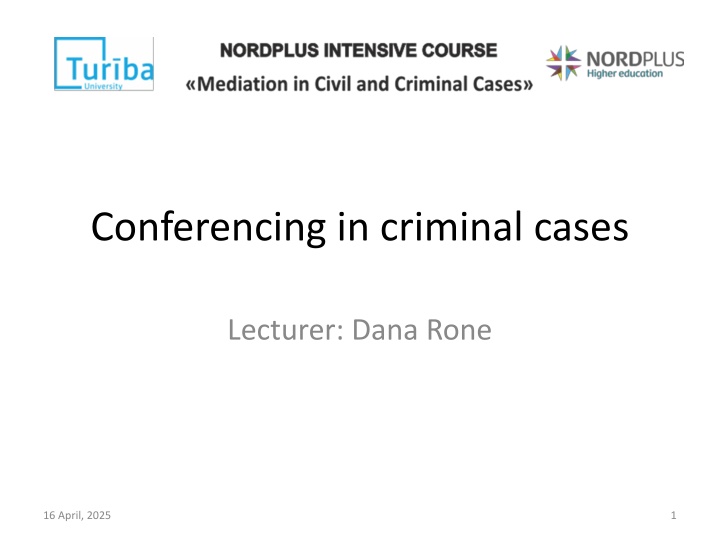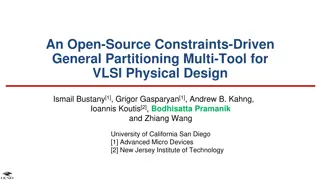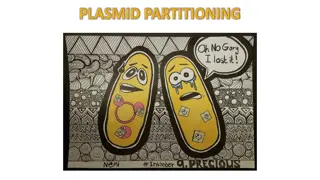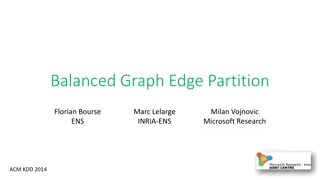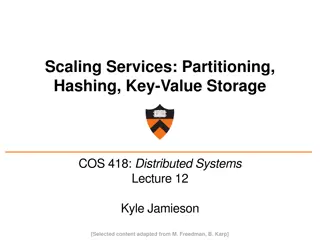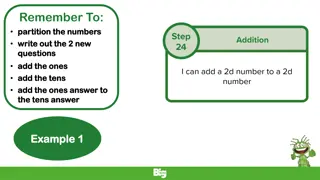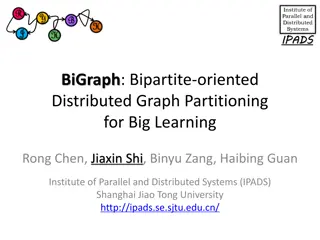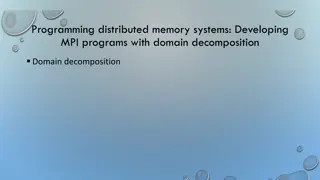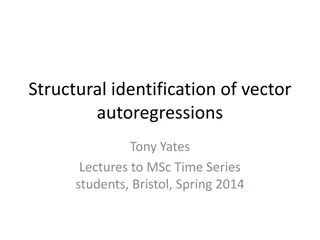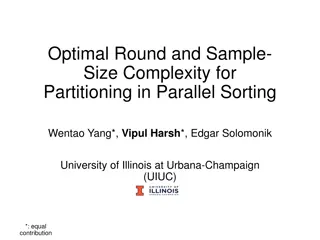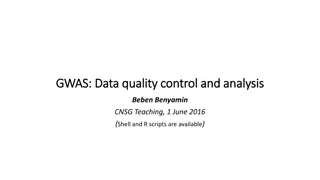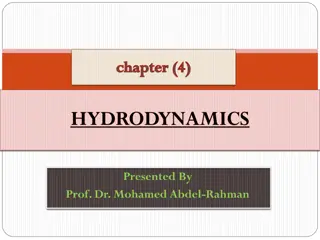Genetic Effects Partitioning with Structural Equation Modeling
How Structural Equation Modeling (SEM) can partition genetic effects of individual SNPs into maternal and fetal components. Learn about the flexibility of SEM, model building, identification concepts, and investigating molecular mechanisms in genetic research.
Download Presentation

Please find below an Image/Link to download the presentation.
The content on the website is provided AS IS for your information and personal use only. It may not be sold, licensed, or shared on other websites without obtaining consent from the author.If you encounter any issues during the download, it is possible that the publisher has removed the file from their server.
You are allowed to download the files provided on this website for personal or commercial use, subject to the condition that they are used lawfully. All files are the property of their respective owners.
The content on the website is provided AS IS for your information and personal use only. It may not be sold, licensed, or shared on other websites without obtaining consent from the author.
E N D
Presentation Transcript
Conferencing in criminal cases Lecturer: Dana Rone 16 April, 2025 1
Method Maori tribes, New Zealand A tribe adopts decision how to help to the victim and what to do with a perpetrator Communication skills essential Ability to ask questions essential Neutrality essential Don t be an expert in other s situation 16 April, 2025 2
Method Questions must be aimed to constructive solutions, not judging or pittying A chance to ask questions and get answers To get fulfillment of one s needs If mediator is nervous, but verbally saying nice things, nobody believe Both verbal (10%) and non-verbal communication (90%) is essential http://www.etiquetteoutreach.com/blog_new-york- etiquette-guide/bid/86444/Body-Language- Breakdown-Crucial-Tips-and-Faux-Pas - Body language 16 April, 2025 3
Non verbal communication: 1) Facial expressions 16 April, 2025 4
Non verbal communication: 2) Gestures https://www.youtube.com/watch?v=_8hAOxsTpVY 16 April, 2025 5
Non verbal communication: 3)Paralinguistics (tone of voice) 16 April, 2025 6
Non verbal communication: 4)Body Language and Posture 16 April, 2025 7
Non verbal communication: 5)Proxemics (personal space) 16 April, 2025 8
Non verbal communication: 6)Eye gaze 16 April, 2025 9
Non verbal communication: 7)Haptics (touch) 16 April, 2025 10
Non verbal communication: 8)Appearance (outlook) 16 April, 2025 11
5 questions aimed at restorative justice 1. What happened? Lets person speak about particular situation 2. What do you think about what happened? Learn about motivation and reaction after event. 3. What did you feel? 4. Who was affected by this event? 5. What should you do now? 16 April, 2025 12
Conferencing meeting 2 mediators (because there is higher risk that in the larger group discriminatory elements will be gender, age, etc.) Victim/-s, offender/-s, supporter/-s Long and effective prior planning of conferencing meeting Knowing participating parties, their mutual relations 16 April, 2025 13
Conferencing meeting mediators sit in front of each other & visually cover the field Mediator 1 A E B F C G D H Mediator 2 16 April, 2025 14
Conferencing meeting mediators sit in front of each other & visually cover the field Mediator covers the persons sitting in front of him Better eye contact Balanced neutrality 16 April, 2025 15
Getting prepared for conferencing meeting Know participants get acquainted before Needs, expectations and concerns Check arriving possibilities (and mind diseabled) 16 April, 2025 16
Social network in conferencing meeting. Better few, but real supporters. Some has many supports, some none Relatives Friends Acquaintances Police 16 April, 2025 17
Getting prepared for conferencing meeting Show the room, where conferencing will take place Victim and offender sits in front of each other Victim must sit in a place, from which he/she can leave any time, not passing by the offender Minor s parents sit besides the child (if someone sits between, the parents will attack offender, which is a normal reaction) 16 April, 2025 18
Structure of mediation. 1 - Past What happened? How did it happen? Who took part in it? Historical events are discussed, summary - made 16 April, 2025 19
Structure of mediation. 2 - Present What do you think about this today? How do you feel today about that? What are the consequences on your life today? How this affected you and your current life? Whould you like to change this situation? What are you ready to do about this? Mediator helps identify feelings, especially of the victim. A perpatrator must see the consequences of his/her offence, and offer the help to the victim. 16 April, 2025 20
Structure of mediation. 3 - Future What you will need to leave this in past? What solution do you offer? What do you think about his/her needs? What can you do to improve the situation? Parties are going fo resulution as precise as possible. 16 April, 2025 21
Speaking sequence and tips The 1st speaks the perpetrator (thus he/she takes responsibility and recognizes the fault) Everybody must speak for himself/herself Not we , but I Equal questions, equal timing for everyone The perpetrator gets a chance to know how his/her behaviour affected the victim and other society supporters, relatives, friends, colleagues, etc. 16 April, 2025 22
Secondary victimization 1. Psychological reaction (anger, fear) 2. Physical reaction (sickness, tearfulness) 3. Behavioral reaction (alcohol, drugs, isolation) Ask the victim, does he/she agree to meet with the perpetrator 16 April, 2025 23
4 stage recovery model 1. Shock, denial (a stable person must assist, be besides) 2. Disorganization, depression (reactive phase; victim feels emotions, is in affect phase 4 6 weeks) 3. Recovery, acceptance (6 12 months) 4. Return back to normal, adaptation (old habits return, new habits come) 16 April, 2025 24
4 stage recovery model 1. 4. 2. 3. 16 April, 2025 25
Factors affecting recovery Has person been a victim before? Has person experienced severe loss recently? Lack of (emotional, physical, etc.) support Type of crime Anamnesis* of mental health * The complete history recalled and recounted by a patient 16 April, 2025 26
Secondary victimization Mental stress caused by inadequate and negative reaction of society Mind society s attitude towards the victim Mediator affects secondary victimization risk A lot of attention shall be paid to the victim in mediation process A victim must be especially informed about mediation, possible agreement, its consequences, the process 16 April, 2025 27
Secondary victimization If victim is not efficiently heard: 1. False expectations 2. Dishonour of promises 3. Later control over situation 4. Lack of respect towards victim 16 April, 2025 28
Final remarks Would you like to say something in addition? Would you like to appologize? 16 April, 2025 29
How to speak in mediation? We will analyze / You will analyze Can you tell us what you did? Don t suggest solutions Is there anything you would like to receive? 16 April, 2025 30
Perpetrators concerns 1. Public hearing and public humiliation (mediator explains rules and doesn t allow offences) 2. Fears from public speach (mediator speaks simply) 3. Emotional pressure (a break is possible in mediation) 4. Will the process be effective 5. Wide-spread information about process (confidentiality is observed) 16 April, 2025 31
Perpetrators parents concerns 1. The child will be punished 2. What society will think about their child? 3. Will they be able to cover damages? 4. What will be the future of their child? Therefore mediator shall: create safe environment explain the process provide information 16 April, 2025 32
Concerns of professionals (police, teachers) 1. How it will affect my environment? Necessity to settle the environment 2. How will affect the future? Mind the reason 3. The professional will be blamed about bad performance. Explanation that a breach of offender is reviewed, not the performance of professional. 16 April, 2025 33
Victims concerns 1. Not to be repeatedly victimized (secondary victimization). Safe environment, sufficient information. 2. Attacks from the side of perpetrator. Do not give hopes about certaintly of agreement. 3. To get confused during mediation. Lack of ability to protect himself/herseft. To get a supporter. 16 April, 2025 34
Thank you! 16 April, 2025 35
